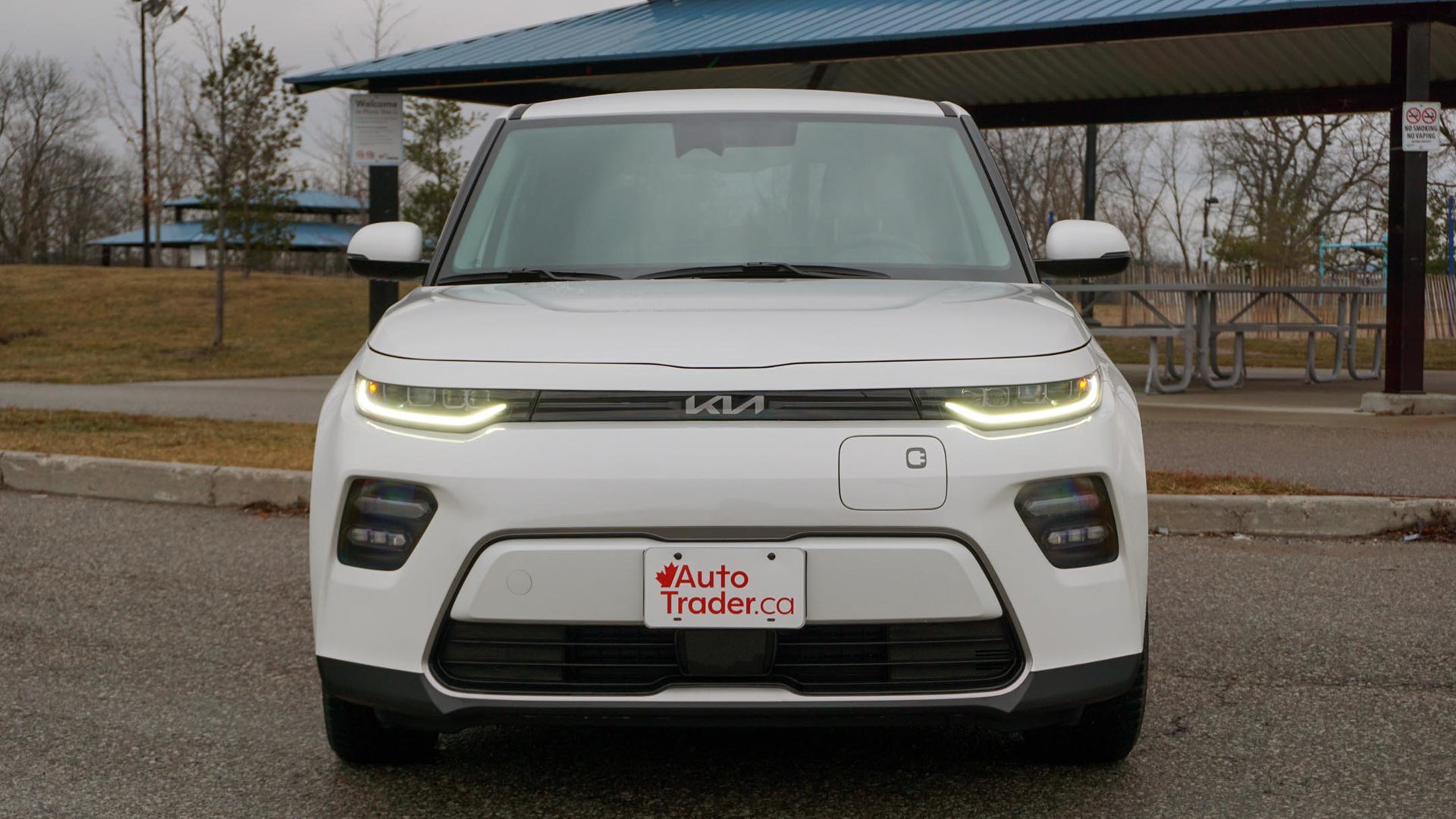 AutoTrader SCORE
AutoTrader SCORE
-
STYLING9/10
-
Safety9/10
-
PRACTICALITY10/10
-
USER-FRIENDLINESS10/10
-
FEATURES9/10
-
POWER8/10
-
COMFORT8/10
-
DRIVING FEEL8/10
-
FUEL ECONOMY8/10
-
VALUE6/10
There aren’t many cars over the last 15 years that have been as lovable as the Kia Soul.
Maybe it’s not quite in Mini Cooper or Volkswagen Beetle territory, but it’s close. Where it differs most from those endearing automobiles, however, is that it’s actually practical. And when it comes to the 2023 Kia Soul EV, very little of that practicality has been sacrificed to make way for its all-electric powertrain.
That’s the good news. The bad news is that range falls a little short of where it probably needs to be. But the Soul EV counters with a couple factors that just might matter more.
Styling: 9/10
Of all the cars to employ such a simple overall look, none has had the staying power of the Soul. The Scion xB had a good run, while the Nissan Cube’s was shorter still. Yet somehow this Kia remains, having been first introduced to the world nearly 15 years ago and still going strong.
Of course, the design has matured substantially compared to the cutesy first- and second-generation versions, with sleek and modern styling cues inside and out. And while the 2023 Soul EV didn’t get the same tweaked looks as its gas-powered sibling, it’s still worthy of praise for making the most of its simple shapes and lines.
User-Friendliness: 10/10
That’s true of the cabin, too, which looks and feels almost identical to the conventional Soul’s. Beyond a few buttons here and there, the biggest change point of note is the rotary gear selector on the centre console; otherwise, the same approachable controls for climate and infotainment take no time to master.
When it comes to the latter, a 10.25-inch touchscreen is mounted low on the dash, which means it does nothing to hinder the excellent outward visibility. The interface is a simple one, feeling a bit like a smartphone thanks to the thumbnail icons and simple menu structure. The display itself is responsive, too, with a good refresh rate when switching between the various features and functions.
Practicality: 10/10
It might not be quite as easy to climb aboard the Soul EV as it is a rival like the Chevrolet Bolt, which was designed and engineered as an electric vehicle (EV) from the outset, but that doesn’t mean doing so is difficult. Large doors and a low step-in make both the front and rear seats easy to access, while the wide tailgate does the same for the cargo area.
There’s no difference between the Soul EV and the gas-powered version when it comes to space behind the back seats, with the same 530 L for stuff (the area can be expanded to 663 L with the load floor lowered). It’s only when those seats are folded that this electric version comes up short, with 1,735 L compared to 1,758 L. Even then, that’s barely a few tote bags worth of space.
The reason for the shortcoming, minor though it may be, is the location of the battery pack under the passenger cell. That means sacrificing a bit of occupant space with the rear seats upright, but there’s still plenty – particularly considering the Soul’s compact dimensions.
Power: 8/10
While there are equipment differences across this Kia’s two-trim lineup, some are more fundamental to the car itself. For starters, the base version has a lower voltage electric motor, producing 134 hp compared to the Soul EV Limited and its 201-hp unit. Regardless, they make the same 291 lb-ft of torque, and that’s the stuff that matters more when accelerating.
Doing so might not come with the same urgency as it does in the performance-focused Ford Mustang Mach-E GT, but there’s still the immediate surge of torque that’s the hallmark of electrification. Better still, however, is how easy it is to roll onto the throttle for acceleration that feels even-keeled and not unlike that of a gas-powered car.
Driving Feel: 8/10
That kind of familiarity for those making their first foray into electrification is a nice touch, and it’s one of the biggest reasons this Kia could be the easiest EV on the market to forget how it’s powered in the first place. Where it could stand to feel more like an EV is its regenerative braking, which lacks a proper one-pedal setting that can bring the car to a stop by simply easing off the throttle. Instead, there are three levels of regeneration that get progressively stronger, while pulling the paddle on the left side of the steering wheel will stop the car; but it doesn’t feel as smooth as a true one-pedal mode.
Comfort: 8/10
Nevertheless, the ride is smooth thanks to the suspension the Soul EV rides on. Whereas the gas version uses a torsion beam in the back that allows bumps and other imperfections to reverberate from one side of the car to the other, the multi-link setup here better isolates each wheel. Add to that supple suspension damping that’s required to compensate for the added weight of the battery pack and other components, and this is a competent cruiser in spite of its economy car roots.
The driver’s seat was equal parts cozy and supportive during testing, neither of which are typical Kia traits. Wrapped in decent leather upholstery in the Limited trim tested here, the three-stage heat was quick to do its job (as was the heated steering wheel). Likewise, the Limited’s heat pump that recovers waste heat from the powertrain to warm the cabin worked efficiently and effectively.
Fuel Economy: 8/10
Like the motor, the battery differs depending on trim – and neither provides exceptional range. Granted, the claimed 383 km the Limited’s 64-kWh pack provides isn’t far from competitors like the Chevy Bolt and Bolt EUV; and it’s a little more than the 363 km provided by the Nissan Leaf Plus. But it’s limiting at the very least. (The Soul EV Premium and its 39.2-kWh fairs even worse, with just 248 km of claimed range.)
However, the Soul EV has in its favour a combination of efficiency and accuracy – two factors that just might matter more than outright range in a runabout like this one. Even a wintertime test like this one didn’t deplete the battery at an alarming rate, unlike the Bolt EUV that delivered disappointing results on the highway. There’s peace of mind that comes with the predictability that an EV can travel the distances advertised, or at least come close to it.
When it’s time to charge, this Kia can be hooked up to a DC fast-charging station at a maximum of 100 kW, with the brand claiming the jump from 10 to 80 per cent will take about 50 minutes in ideal conditions. That the battery was boosted from 34 to 80 per cent in that amount of time on a cold and rainy day is another testament to the Soul EV’s accuracy.
Features: 9/10
Beyond their electrical components, the two trims offer differing levels of equipment, though even the entry-level version has a good selection of stuff. There are heated front seats and a heated steering wheel, automatic climate control with an energy-saving driver-only mode, touchscreen infotainment, wired Apple CarPlay and Android Auto connections, and built-in navigation that can map nearby charging stations.
Both trims also come with Kia’s remote connected services that allow a paired smartphone to do everything from start and stop charging to precondition the cabin. Meanwhile, the Soul EV Limited adds ventilation to the front seats, as well as heated rear seats, leather upholstery, and an upgraded stereo. It also features a sunroof, interior ambient lighting, and an efficient heat pump that warms the cabin.
Safety: 9/10
Disappointingly, Kia dropped the head-up display and rain-sensing wipers from the Soul EV’s equipment list this year. Otherwise, both trims have six airbags throughout the cabin, a new rear occupant alert system, lane following assist, blind-spot collision avoidance, and junction turn assist that can warn of approaching traffic when making a left turn through an intersection.
Other safety kit includes adaptive cruise control that works in stop-and-go traffic, forward collision warning with automatic emergency braking, and blind-spot monitoring with rear cross-traffic alert. There’s also the brand’s highway drive assist system that automates some steering inputs should a driver’s hands remain on the wheel.
Value: 6/10
While its equipment list far exceeds what competitors like the Bolt and Nissan Leaf offer, so too does the Soul EV’s asking price. It starts at $44,895 before tax and rebates – but including a non-negotiable freight charge of $1,800 – while the Limited trim rings in at $53,895. Meanwhile, Chevy says the Bolt should start at about $43,000 and the Bolt EUV at $45,000, with only the latter available with expensive add-ons like adaptive cruise control or a panoramic sunroof, while the Leaf is priced between $42,000 and $48,000. Even so, it’s a lot of money for not a lot of range.
The Verdict
The 2023 Kia Soul EV might lack outright range, but it makes up for it with efficiency and accuracy, and it’s reasonable to argue that those factors matter more. Add in the familiar driving feel and tons of usable space inside, and the shortcomings seem even more minor in the grand scheme of all the good stuff this Soul delivers.
| Engine Displacement | 150 kW |
|---|---|
| Engine Cylinders | Single electric motor |
| Peak Horsepower | 201 hp |
| Peak Torque | 291 lb-ft |
| Fuel Economy | 1.9 / 2.4 / 2.1 Le/100 km, 16.9 / 21.0 / 18.7 kWh/100 km city/hwy/cmb; 383 km est. range |
| Cargo Space | 530 / 1,735 L seats up/down |
| Model Tested | 2023 Kia Soul EV Limited |
| Base Price | $52,095 |
| A/C Tax | $100 |
| Destination Fee | $1,800 |
| Price as Tested | $54,245 |
|
Optional Equipment
$250 – Snow White Pearl paint, $250
|
|







































